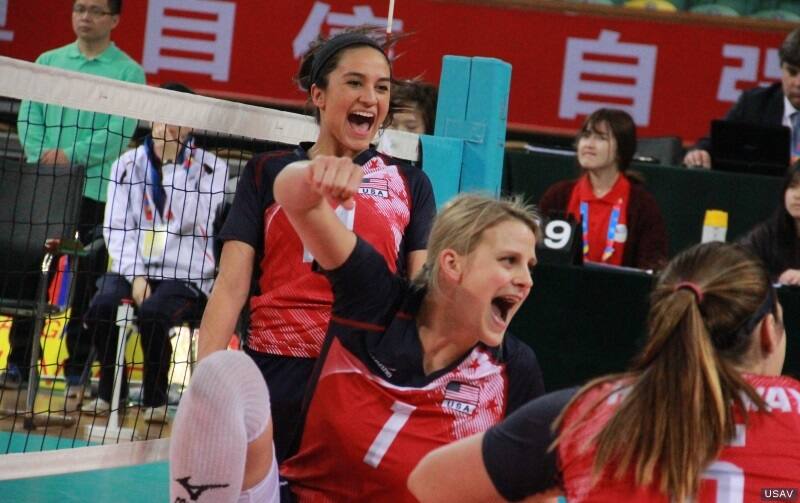
COLORADO SPRINGS, Colo. (April , 2016) – If you did a double take when looking at Kaleo Kanahele’s athletic resume, you wouldn’t be alone.
Before her 18th birthday, the Edmond, Oklahoma native not only won a volleyball high school state championship, she helped the U.S. Women’s Sitting Team win a silver medal at the 2012 London Paralympics.
However, Kanahele isn’t alone in her unusual accomplishment. Teammate Lora Webster (Phoenix, Arizona) also has both a Paralympic medal and state high school title to her name. Webster helped the U.S. win a bronze medal during the 2004 Athens Paralympics just months after graduating from Cactus Shadows High School, and also played on the 2008 and 2012 Paralympic silver medal-winning teams.
Only a fraction of the millions of athletes who play sports with Olympic or Paralympic ambitions will see their dreams fulfilled, making Kanahele and Webster’s accomplishments even more remarkable.
“I’ve had that ‘Wow’ moment often,” Kanahele said. “Right before London I realized, “Oh my gosh, this is my life. This is what I get to do,’ and it really blew my mind that I was going to the Paralympics.”
Kanahele and Webster are not the only members of the Women’s Sitting Team to play high school volleyball. Lexi Shifflett (Waseca, Minnesota), Courtney Baker (Crofton, Kentucky), Nicky Nieves (Kissimmee, Florida), Heather Erickson (Fayetteville, North Carolina) and Bethany Zummo (Dublin, California) are among those who also played; Nieves and Baker also played in college.
Others, such as Katie Holloway (Lake Stevens, Washington) or Monique Burkland (Ardmore, Oklahoma), excelled in sports such as basketball or softball.
Volleyball helped Webster recover from a battle with osteosarcoma, a bone cancer that forced doctors to amputate her left leg below the knee at age 11. She underwent a rotationplasty, during which her limb was rotated and the ankle bone was attached in place of the knee joint, allowing her to still run and jump.
“Prior to getting sick I loved soccer and I was good at it,” Webster said. “But after, I started playing volleyball and basketball (with my prosthetic leg). There was too much running in basketball. Once I got back on my feet, volleyball was the sport that fit the new me the best.”
Kanahele started playing volleyball at age 10, beginning to train with the U.S. Sitting Teams two years later. Playing both standing and sitting, “became difficult,” but didn’t inhibit success in either medium.
“I think it made the track to learning sitting a little longer just because of having to readjust my game and still learning it,” she said. “It’d be so strange in warmups. They have the same skills, but you play it so differently.”
Kanahele was born with a club foot; a surgical procedure at 9 months old to set the heel bones in her left foot left her with limited calf muscles and flexibility. However, the disability didn’t prevent her from starting for her high school’s varsity team sophomore through senior years, earning All-State honors her senior year.
Webster also joined the Sitting Team while still in high school; she is the only inaugural member still playing for the U.S. Women’s Sitting Team. Unlike Kanahele, Webster said playing sitting helped improve her standing volleyball abilities.
“The mechanics of your hands and platform get better because you don’t have the benefit of using your legs,” Webster said. “Everything comes from the upper body, so when you add your legs you’re ten times ahead of everyone else.”
Shifflett also said she felt the transition was fairly smooth, while Nieves – who predominantly played outside hitter or middle blocker and also ran track and did cheerleading in high school – encountered more of an adjustment.
“(Sitting) is so much faster and your reaction times have to be a lot better,” Shifflett added.
“In standing volleyball I felt like I could rely on my legs to help power me over the block,” Nieves said. “In sitting I can’t jump to attack over the block, so I have to use my head a lot more. It was very frustrating at first.”
But now the team has turned its attention toward the Rio de Janeiro Paralympics in September. The U.S. Women’s Sitting Team is considered a strong contender for the gold medal after back-to-back silver medals at the 2008 and 2012 Paralympics, as well as a dominating performance during the World ParaVolley Intercontinental Cup in March.
Despite accomplishing so much at a relatively young age, Kanahele said a Paralympic gold would be the ultimate career-highlight.
“Really my entire life I wanted to be an Olympian, so the fact I get to do it this way, with this sport, at this age… it really blows my mind,” she said.
